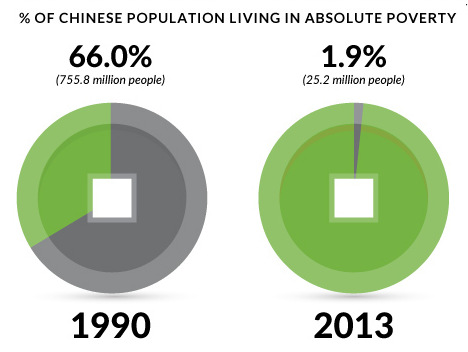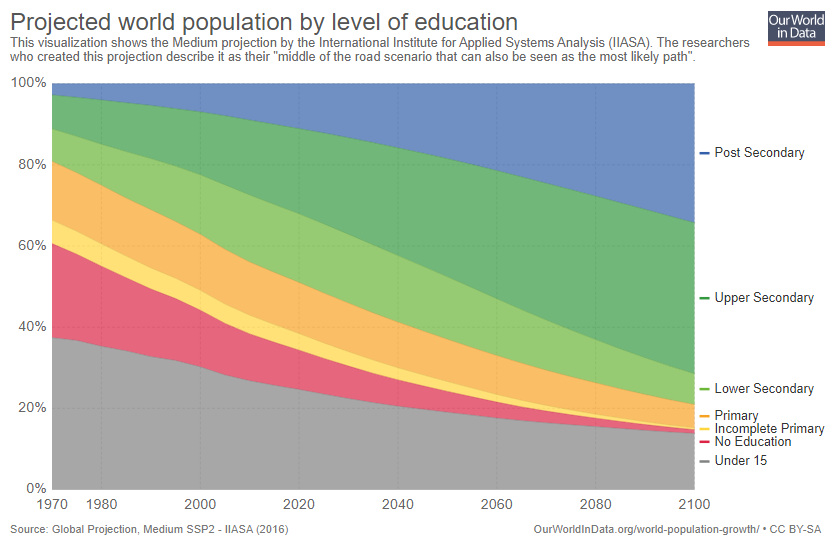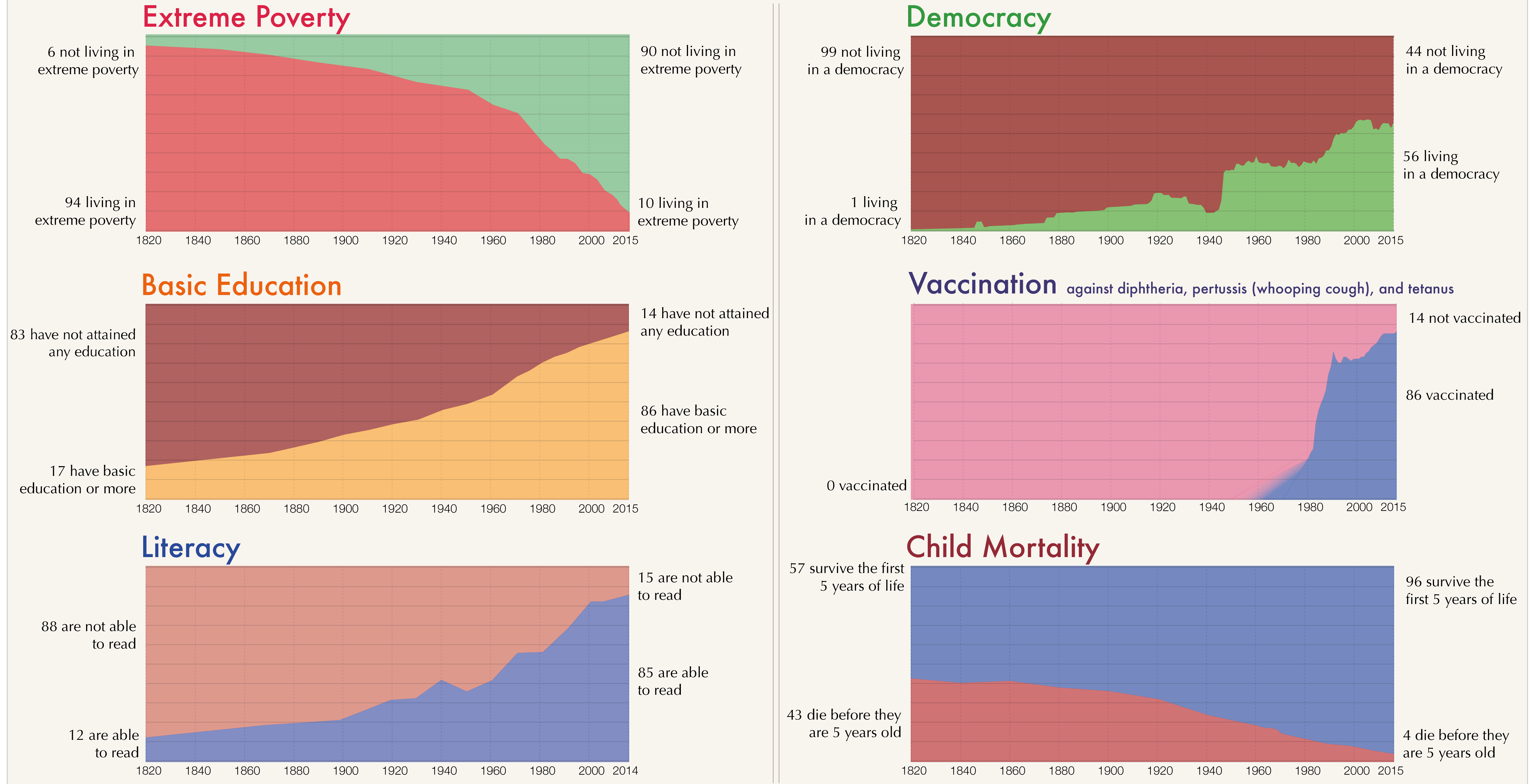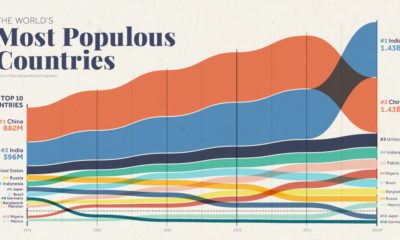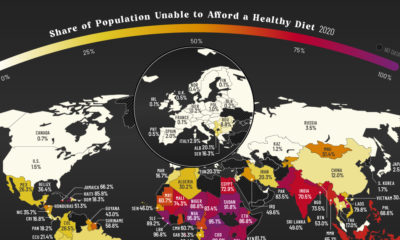It only takes a few minutes of cable news to get the feeling that the world is heading into a tailspin.
Endless images of homicide investigations, natural disasters, car crashes, and drug busts fill the airwaves on a daily basis. It’s upsetting – but also certainly captivating for the average viewer.
In fact, the news cycle thrives on fear and violence, so mainstream networks find a way to fill up 99% of programming with these singular events. It’s addicting and sometimes anger-inducing, but is it representative of what’s really going on in the world?
Good News Happens Slowly
Today’s infographic comes to us from economist Max Roser of Our World in Data, and it highlights six megatrends that show that in many important ways, our world is improving drastically. The one commonality of these six indicators? They all happen slowly and incrementally, but are more evident with a long-term perspective. Each family lifted out of poverty, each classroom that gets built, and each village gaining access to basic vaccinations may not seem significant on a scale of billions of people – but over decades, these gains add up to create a richer, more educated, and healthier world and a very powerful statistical story.
Six Global Trends
Here are the six big picture trends pointed out by Roser, using data collected over hundreds of years:
- Extreme Poverty The portion of people in extreme poverty – making less than $1.90 per day – has dropped like a rock over the years. Back in 1940, about 75% of the world was in extreme poverty – today, that number is just 10%. The most potent recent example of this is China, where access to free markets have enabled 700 million people to be lifted out of poverty in just over 20 years.
It’s also worth mentioning that statistics for this category are done using inflation-adjusted international dollars, which take into account inflation over time as well as exchange rates. Non-monetary forms of income are also included in the calculations. 2. Basic Education In 1820, only a privileged few were able to get basic schooling. Since then, millions of classrooms and schools have been added around the globe, and the numbers are staggering. In relative terms, we’ve gone from 17% of people having a basic education to 86% today. Here’s a more detailed breakdown of this, also from Our World in Data:
- Literacy Following a similar trend line as basic education, literacy has risen from 12% to 85% over roughly two hundred years. In absolute terms, these numbers are even more impressive. In the 1820s, there were only about 100 million people that could read that were 15 years or older. Today, the number stands at 4.6 billion.
- Democracy While the world has been having some short-term setbacks when it comes to freedom and democracy, the overall trend line is still impressive over the long run. In 1900, only 1 in 100 people worldwide lived in a democracy – and today, the majority (56 in 100) can say they live in a country with free and fair elections.
- Vaccination Vaccinations for diseases like whopping cough, tetanus, and diphtheria were unavailable for most of the 200 year chart. However, today around 86% of people globally are vaccinated against these basic and devastating illnesses.
- Child Mortality Even as far back as 1920, it used to be that over 30% of infants would die before they hit their 5th birthday. Since then, developments in housing, sanitation, science, and medicine have made it so that death is a much rarer occurrence for the youngest people in our society. Today, on a global basis, child mortality has been reduced to 4%. on But fast forward to the end of last week, and SVB was shuttered by regulators after a panic-induced bank run. So, how exactly did this happen? We dig in below.
Road to a Bank Run
SVB and its customers generally thrived during the low interest rate era, but as rates rose, SVB found itself more exposed to risk than a typical bank. Even so, at the end of 2022, the bank’s balance sheet showed no cause for alarm.
As well, the bank was viewed positively in a number of places. Most Wall Street analyst ratings were overwhelmingly positive on the bank’s stock, and Forbes had just added the bank to its Financial All-Stars list. Outward signs of trouble emerged on Wednesday, March 8th, when SVB surprised investors with news that the bank needed to raise more than $2 billion to shore up its balance sheet. The reaction from prominent venture capitalists was not positive, with Coatue Management, Union Square Ventures, and Peter Thiel’s Founders Fund moving to limit exposure to the 40-year-old bank. The influence of these firms is believed to have added fuel to the fire, and a bank run ensued. Also influencing decision making was the fact that SVB had the highest percentage of uninsured domestic deposits of all big banks. These totaled nearly $152 billion, or about 97% of all deposits. By the end of the day, customers had tried to withdraw $42 billion in deposits.
What Triggered the SVB Collapse?
While the collapse of SVB took place over the course of 44 hours, its roots trace back to the early pandemic years. In 2021, U.S. venture capital-backed companies raised a record $330 billion—double the amount seen in 2020. At the time, interest rates were at rock-bottom levels to help buoy the economy. Matt Levine sums up the situation well: “When interest rates are low everywhere, a dollar in 20 years is about as good as a dollar today, so a startup whose business model is “we will lose money for a decade building artificial intelligence, and then rake in lots of money in the far future” sounds pretty good. When interest rates are higher, a dollar today is better than a dollar tomorrow, so investors want cash flows. When interest rates were low for a long time, and suddenly become high, all the money that was rushing to your customers is suddenly cut off.” Source: Pitchbook Why is this important? During this time, SVB received billions of dollars from these venture-backed clients. In one year alone, their deposits increased 100%. They took these funds and invested them in longer-term bonds. As a result, this created a dangerous trap as the company expected rates would remain low. During this time, SVB invested in bonds at the top of the market. As interest rates rose higher and bond prices declined, SVB started taking major losses on their long-term bond holdings.
Losses Fueling a Liquidity Crunch
When SVB reported its fourth quarter results in early 2023, Moody’s Investor Service, a credit rating agency took notice. In early March, it said that SVB was at high risk for a downgrade due to its significant unrealized losses. In response, SVB looked to sell $2 billion of its investments at a loss to help boost liquidity for its struggling balance sheet. Soon, more hedge funds and venture investors realized SVB could be on thin ice. Depositors withdrew funds in droves, spurring a liquidity squeeze and prompting California regulators and the FDIC to step in and shut down the bank.
What Happens Now?
While much of SVB’s activity was focused on the tech sector, the bank’s shocking collapse has rattled a financial sector that is already on edge.
The four biggest U.S. banks lost a combined $52 billion the day before the SVB collapse. On Friday, other banking stocks saw double-digit drops, including Signature Bank (-23%), First Republic (-15%), and Silvergate Capital (-11%).
Source: Morningstar Direct. *Represents March 9 data, trading halted on March 10.
When the dust settles, it’s hard to predict the ripple effects that will emerge from this dramatic event. For investors, the Secretary of the Treasury Janet Yellen announced confidence in the banking system remaining resilient, noting that regulators have the proper tools in response to the issue.
But others have seen trouble brewing as far back as 2020 (or earlier) when commercial banking assets were skyrocketing and banks were buying bonds when rates were low.
